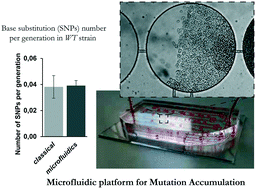Microfluidic platform for monitoring Saccharomyces cerevisiae mutation accumulation†
Abstract
Mutations in DNA have large-ranging consequences, from evolution to disease. Many mechanisms contribute to mutational processes such as dysfunctions in DNA repair pathways and exogenous or endogenous mutagen exposures. Model organisms and mutation accumulation (MA) experiments are indispensable to study mutagenesis. Classical MA is, however, time consuming and laborious. To fill the need for more efficient approaches to characterize mutational profiles, we have developed an innovative microfluidic-based system that automatizes MA culturing over many generations in budding yeast. This unique experimental tool, coupled with high-throughput sequencing, reduces by one order of magnitude the time required for genome-wide measurements of mutational profiles, while also parallelizing and simplifying the cell culture. To validate our approach, we performed microfluidic MA experiments on two different genetic backgrounds, a wild-type strain and a base-excision DNA repair ung1 mutant characterized by a well-defined mutational profile. We show that the microfluidic device allows for mutation accumulation comparable to the traditional method on plate. Our approach thus paves the way to massively-parallel MA experiments with minimal human intervention that can be used to investigate mutational processes at the origin of human diseases and to identify mutagenic compounds relevant for medical and environmental research.



 Please wait while we load your content...
Please wait while we load your content...